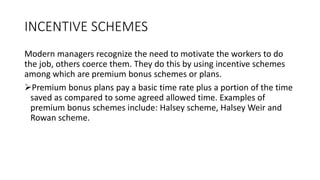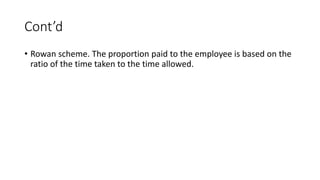Accounting for labour can be classified into labour costing for managers and payroll accounting. For labour costing, source documents like job cards, clock cards, timesheets, and wage sheets are used to track employee time and calculate labour costs to charge to jobs and overhead accounts. Payroll accounting records amounts owed to employees and tax/pension funds. Common incentive schemes that pay bonuses for productivity include Halsey, Halsey-Weir, and Rowan schemes. Idle time represents unpaid time and is classified as normal or abnormal, with normal time charged to overhead and abnormal time investigated. Controlling idle time involves proper planning, maintenance, and supervision.


























